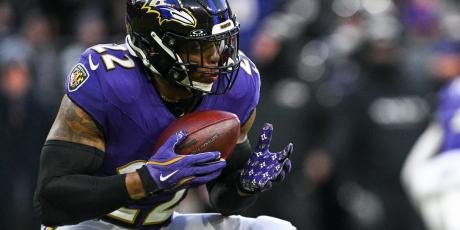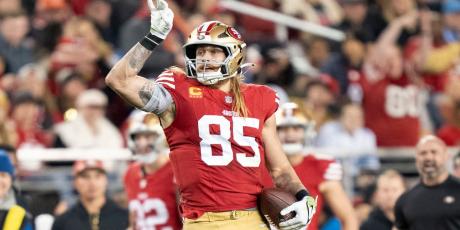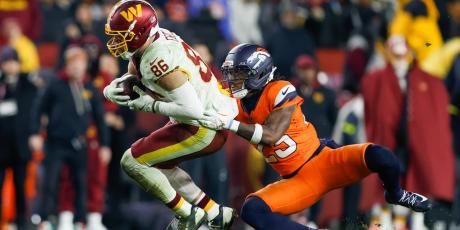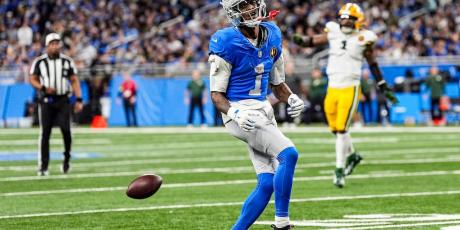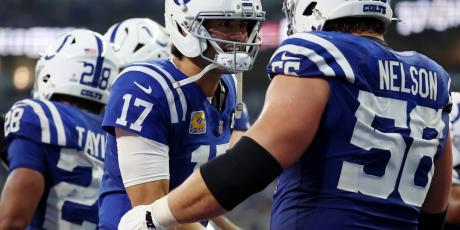How Play-Calling Tendencies Affect Fantasy Football
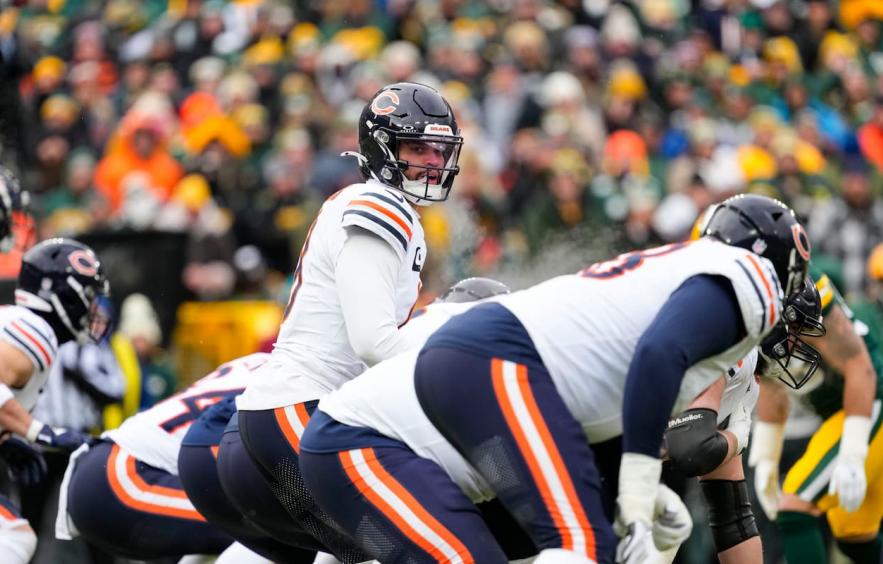
We’ve got 12 new offensive play callers for the 2025 season, slightly lower than the 14 from 2024. And just like last year, I’ll re-introduce some key topics like pass rate over expected (PROE) and pace. These topics are key to understanding what these play callers want to do. And then I’ll go team by team, discussing what we’re likely to see with the league’s new play callers.
PROE, Pace, and Play Action
Let’s start with pass rate over expected (PROE). The graph below shows a team’s PROE on the x-axis and how much that fluctuated weekly on the y-axis. PROE starts by calculating how often a typical team would pass in a given situation (i.e. down, distance, score differential, etc.). And then it compares what a team actually did in that situation. Teams that passed more than expected have a PROE above zero, and the opposite is true for teams that passed less than expected. Last year, we saw the continued shift toward the run as indicated by the vertical dashed line on the graph showing the league-wide PROE average at about -2%.
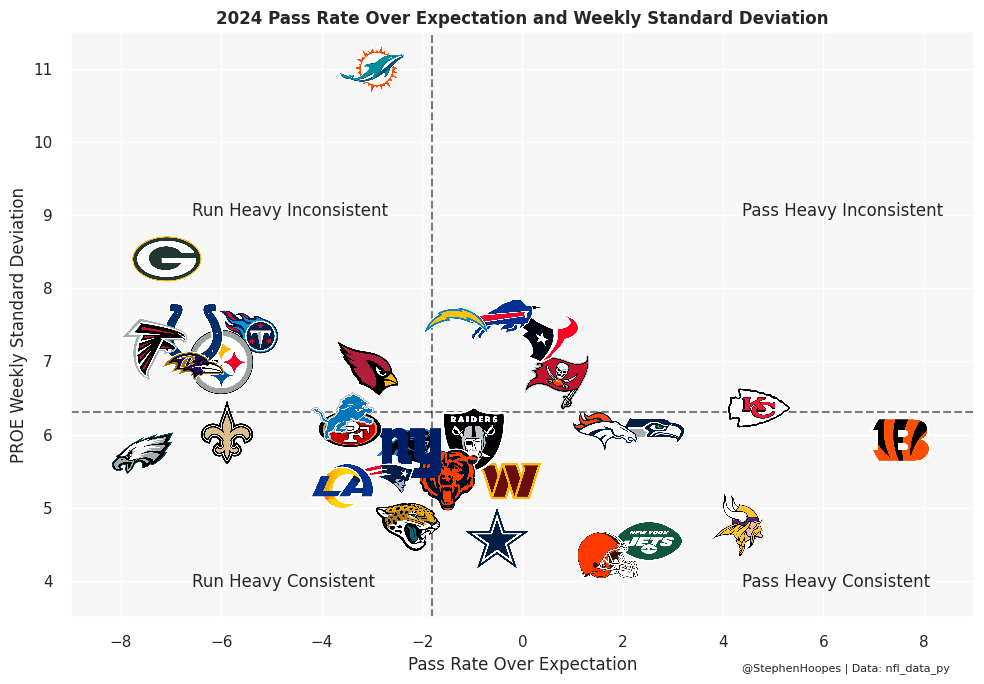
Next up is pace. The graph below shows team pace on the x-axis and their no-huddle rate on the y-axis. The pace metric is the average number of seconds remaining on the play clock at the snap. And we’re only looking at neutral situations. That means plays in the first three-quarters of the game where the score is within eight points, excluding the last two minutes of the half. For the eagle-eyed readers, both the Eagles and Commanders are excluded from the graph to make it easier to see the other teams. But both would be in the top-right quadrant.
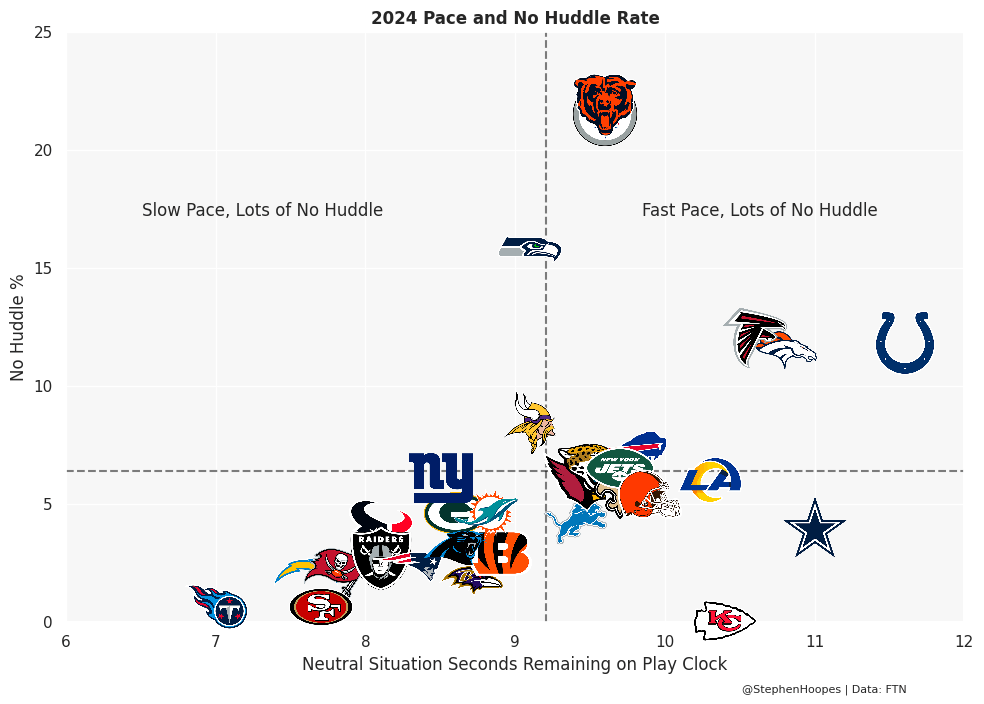
And the final topic before digging into team-level expectations is expected points added (EPA) on play-action passes. EPA measures how much each play impacts a team’s potential to score. If the team’s likelihood to score increases after a play, then EPA increases, and the opposite is true if the team’s scoring potential decreases. The y-axis of the graph below shows EPA by dropback only on play-action attempts. The x-axis is just the raw number of play-action dropbacks last year.
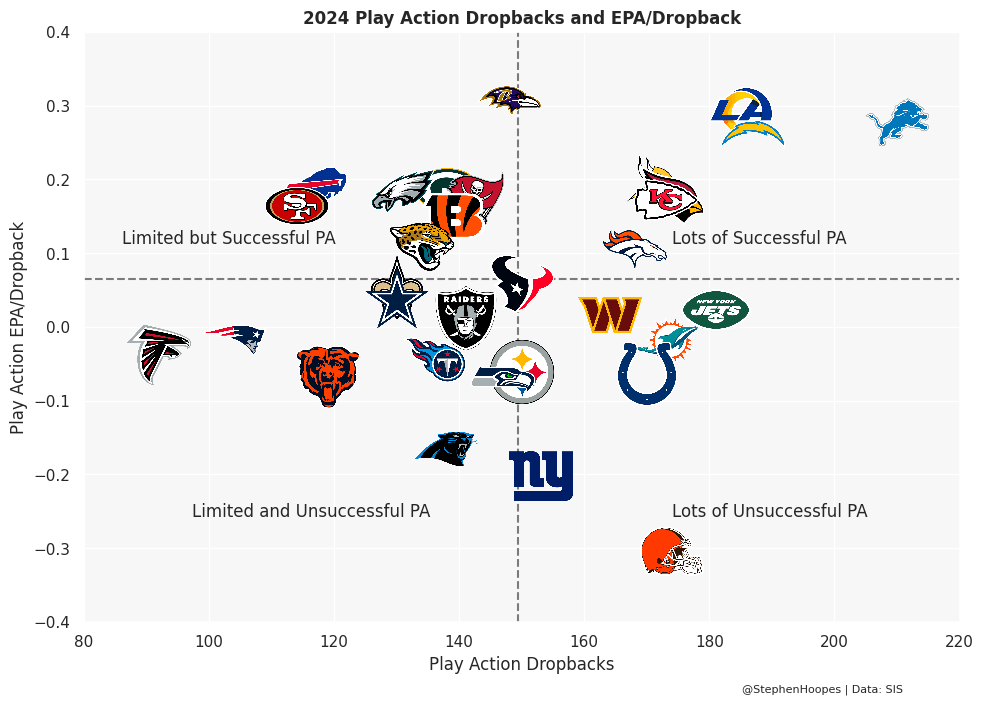
Team-by-Team Analysis
Chicago Bears
The Bears nabbed Ben Johnson this offseason, the most sought-after head-coaching candidate in recent memory. The Lions turned into a perennial top-five offensive unit under Johnson’s tenure as offensive coordinator. He is well-known for tailoring his system to the talents of his roster. And boy is there ever room for improvement in Chicago’s offense.
Caleb Williams finished last season with a brutal -0.08 EPA per dropback along with a similarly awful 33.8% first down rate. Both of those marks are near the bottom of the 20 highest-drafted fantasy quarterbacks in 2025. But there is room for optimism. The Bears revamped their offensive line this offseason, trading for veteran guards Joe Thuney and Jonah Jackson and signing center Drew Dalman in free agency. But the real optimism is from Johnson stepping in as play caller.
The Bears were average in PROE last year at about -2%. But based on their roster and offseason decisions, I’d expect their pass rate to increase in 2025. Their top RB is D’Andre Swift, one of the least-efficient starting RBs in the NFL. And someone whose experience with Johnson in Detroit prompted the Lions to subsequently draft Jahmyr Gibbs.
Similarly, I’d expect more play-action pass attempts. On the play action graph above, the Lions and Bears are in polar opposite regions, with the Lions leading the league in successful play action dropbacks and the Bears bottom-five in attempts and bottom-eight in efficiency.
And it’s basically the same story with middle-of-the-field (MOF) passing. Jared Goff led the league in passes to the middle of the field last year, while Williams was bottom-three among qualified passers. My confidence in more MOF passing is also buoyed by the Bears’ draft decisions, where they selected a pass-catching TE and a slot/flanker WR with their first two picks.
In short, I think this offense is going to lean toward easy-button throws for Williams, especially compared to last season. They should pass more often, given the state of their RB room. We should see more play-action attempts and attempts over the middle of the field. And I’d expect Williams’ average target depth to drop, with Goff’s aDoT a full yard lower than Williams’ in 2024. Because of all of this, Colston Loveland is my favorite target in the Bears’ passing game.
Dallas Cowboys
The Cowboys promoted Brian Schottenheimer to head coach this offseason after serving as their offensive coordinator for the past two seasons. My initial instinct was that Schottenheimer would want a run-heavy identity. But now I don’t think that’s what will happen in practice. The Cowboys seemed to learn the wrong lesson from overpaying at RB in the past. They now think they can add any RB off the scrap heap and start him without consequence.
And the fantasy market has taken notice. You’ll draft at least one RB from the other 31 NFL teams before needing to select Javonte Williams, Miles Sanders, or Jaydon Blue. The Cowboys also went out and traded for George Pickens, who should serve as a much-needed receiver option behind CeeDee Lamb. So, I’d be pretty surprised if the Cowboys actually went run-heavy given the state of their roster.
The Cowboys didn’t use a lot of no-huddle last year, but still operated with a ton of pace. We’ve had some comments this offseason from Schottenheimer that suggest this could continue. So, my preferred way to play this ambiguous backfield is pass-catching rookie Jaydon Blue if we think the Cowboys will be pass-heavy and playing quickly.
Detroit Lions
With Ben Johnson leaving for the Bears head coaching gig, the Lions hired John Morton as their offensive coordinator and play caller. He was with the Lions for the early years of the Dan Campbell era before working with the Broncos for the past two years. We do have a small sample of Morton calling plays in the NFL, but it was for the 2017 Jets. That roster was led by Josh McCown, Bilal Powell, and Robbie Chosen. I don’t think we should pin the lack of success there on Morton.
Morton seems very aware that you shouldn’t mess with the number one scoring offense too much. But if it were so easy to do what Ben Johnson was doing, every team in the league would do it. As far as who Morton might benefit for fantasy, he’s been hyping up Jameson Williams a lot during camp. Morton has made statements about Williams growing mentally and running a wider route tree this year. Additionally, my hope is that Morton brings more concentrated touches to this offense without Ben Johnson scheming up touchdowns to his third-string offensive tackle.
Jacksonville Jaguars
The Jaguars almost flubbed this one by trying to retain their GM Trent Baalke. But once they decided they could move on from Baalke, they were able to sign a very sought-after head coaching candidate in Liam Coen. We only have a one-season sample from Coen, but it was a fantastic sample with the Buccaneers. He was able to spike Baker Mayfield’s TD rate, which is exactly the outcome we’re trying to find in our less-mobile fantasy QBs.
One thing Coen did with Mayfield was substantially lower his average target depth. It was consistently around 8.6 to 9 yards throughout his career before dropping to 6.8 yards last year, which was in the bottom six among qualified passers. That was especially true when Mayfield was targeting Chris Godwin. Similar to Caleb Williams in Chicago, the hope is that we give Trevor Lawrence some more layup throws over the middle of the field, rather than expecting him to bail out the Jaguars on deep pass attempts over and over again. We’ll need Lawrence’s efficiency to increase because Coen’s offense was one of the slowest in the league last year.
The biggest beneficiary here to me is Brian Thomas Jr. There’s been some discussion that we could see Thomas in the slot more often this year. That would be absolutely massive for his ceiling. Thomas’ slot rate was only 28.4% with an aDoT second-highest among top fantasy WRs. As I found in the Most Predictable Wide Receiver Stats article, keeping his aDoT down with increased slot targets to go along with his alpha outside role is the easiest way to get a spiked fantasy ceiling.
Las Vegas Raiders
Chip Kelly is now the offensive coordinator for the Raiders, and he’s well-known for playing extremely up-tempo. Now, he slowed things down a lot at Ohio State last year. And I don’t think we ever see pace like we did in his previous NFL stops again. But it’s a pretty safe bet that the Raiders will not be one of the five slowest teams in the league again this season.
I also think Kelly will want to establish the run, especially after taking Ashton Jeanty with the sixth overall pick in the draft. But the dichotomy between wanting to run the ball and being able to do so with their sportsbook win projection will be interesting to watch. My best guess is they’ll be more pass-heavy than they want to be and playing with a lot of pace. And we’ll see a heavy dose of 2-TE sets with both Brock Bowers and Michael Mayer.
New England Patriots
Another play caller we have a lot of experience with is Josh McDaniels, re-joining the Patriots. And he’s had a ton of success in the past with the Pats, including eight top-10 offenses in his 13 seasons as offensive coordinator. But one pretty important piece of context there is that Tom Brady was the quarterback during that span. I think we can all agree that McDaniels wasn’t really the driving factor in the Patriots' success.
Speaking of Brady, McDaniels’ offenses played very fast during the Brady years. But his offenses were also pretty quick with Cam Newton and Mac Jones as his starting quarterbacks. And then we have very slow seasons with guys like Derek Carr. All in, I think both the success and pace of this offense will be determined by how good Drake Maye is. But I think McDaniels philosophically will want to be balanced with play-action shots.
New Orleans Saints
The one thing we know for sure with a Kellen Moore-led offense is that it will be fast. I did a study last season that looked into whether a new play caller or a veteran quarterback determines pace. And I found that in the majority of cases, it’s the veteran quarterback who dictates the pace of the offense. But there are exceptions. Kellen Moore is one of those exceptions. The graph below shows the pace at which Dak Prescott played before and after Kellen Moore’s hiring in Dallas. The offense sped up instantly by two-to-six seconds each season.
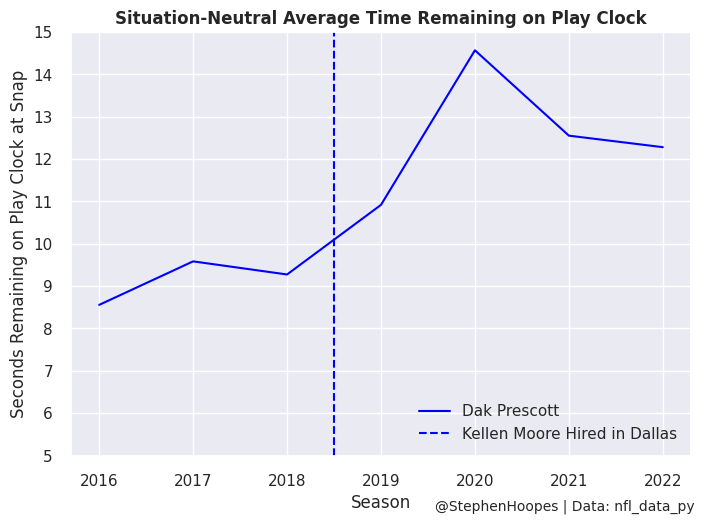
We saw the Chargers play with pace when Moore was there. We even saw the Eagles play with a ton of pace and no huddle last year despite running at a prehistoric rate. The Saints are going to play fast this year. The problem is, they might be awful.
Seeing Jake Haener getting first-team reps in training camp scares the crap out of me. Moore’s pace should at least offset some of the terrible efficiency with volume. My preferred way to play the Saints is through Chris Olave, who has yet to turn in a season below 2.0 yards per route run. If one of Tyler Shough or Spencer Rattler isn’t the worst QB in the NFL, Moore should be able to work with Olave’s talent, especially if he’s getting more work out of the slot and a lower target depth compared to last year.
Seattle Seahawks
Speaking of the Saints, Klint Kubiak was the Saints’ offensive coordinator last year. And he started with two games that launched a thousand articles. The Saints offense looked like world-beaters, putting up 91 points in two games. But as it turned out, those were against two of the worst defenses in the league, in the Cowboys and Panthers. And the Saints then averaged 16.5 points per game against all other teams. Womp womp.
The Seahawks started last season playing fast and pass-heavy. They averaged a PROE of 8.5% through Week 5, which was higher than the first-place Bengals if sustained over the full season. But then there was a marked shift where the Seahawks ran the ball more than expected the rest of the way. And it feels like the firing of previous offensive coordinator Ryan Grubb was due to philosophical differences on pass rate with head coach Mike Macdonald.
Well, Klint Kubiak coming from the Shanahan tree fits that philosophy like a glove. It almost feels like he’s being brought in specifically to run the ball more. Because of that, my preferred way to play this is through Kenneth Walker. He had an absolutely fantastic PFF run grade along with a stellar elusive rating last year. If Kubiak’s scheme can get him to the second level, we could see a big spike in long TDs this year. That is, if the offensive line can hold up.
First Time Coordinators: Texans, Jets, Eagles, and Buccaneers
I’m lumping these teams together because they’ve each hired offensive coordinators without any past play-calling experience for us to lean on. Let’s start with the Texans, who hired Nick Caley to be their new offensive coordinator. He spent the last two seasons with the Rams under Sean McVay. And he’ll need to find a way to work around a bad offensive line and now an extremely questionable RB room with Joe Mixon’s foot injury. My guess is we’ll see some McVay tendencies with a faster pace and lots of play-action passes. But will we see a consistently run-heavy approach given the o-line and RBs, or could we see a spiked pass rate here?
The New York Jets hired Tanner Engstrand, who spent three years in Detroit as the passing game coordinator. The Lions were about average in pace and on the run-heavy side, but made up for it with efficiency. My concern is that we won’t have that efficiency with the Jets. But with Justin Fields at the helm, I’m very confident the Jets will be even more run-heavy than the Lions were last year.
My Philadelphia Eagles promoted Kevin Patullo to offensive coordinator with the departure of Kellen Moore to New Orleans. He’s spent four seasons as passing game coordinator. My most sports-talk-radio take is that Nick Sirianni is mostly along for the ride here. And so, my trust in him promoting one of his guys to OC is pretty limited. The Brian Johnson promotion in 2023, as an example, was a disaster. My guess is the Eagles continue to run at a prehistoric rate this season, but maybe with some additional down-the-field passing based on camp comments.
And finally, the Buccaneers promoted passing game coordinator Josh Grizzard. He’s got some big shoes to fill with Liam Coen taking the head coaching gig in Jacksonville. The Buccaneers played pretty slowly last season. And Grizzard spent two years working under Mike McDaniel on the Dolphins. In general, offenses that use a lot of pre-snap motion tend to be slower. And that makes sense, as there is simply time needed before the snap to execute that motion. My guess is the Buccaneers continue to be pretty slow with a neutral PROE. My preferred way to play this is through Emeka Egbuka due to the Chris Godwin injury concerns.


